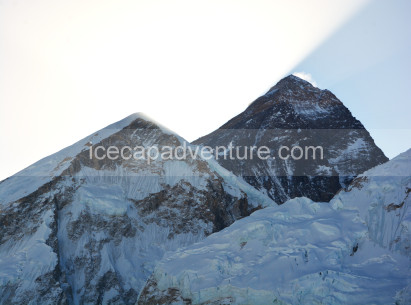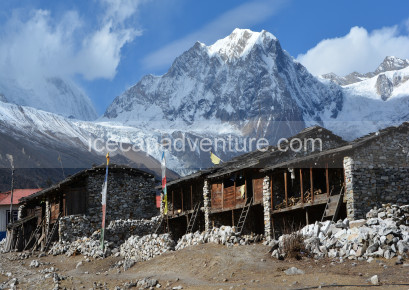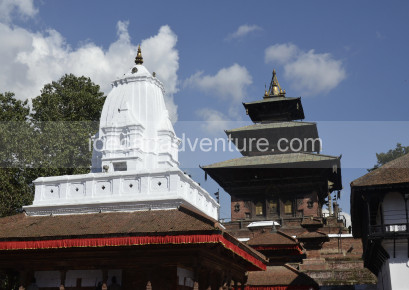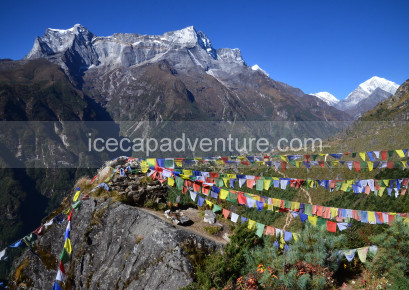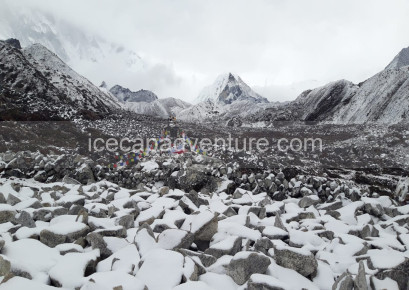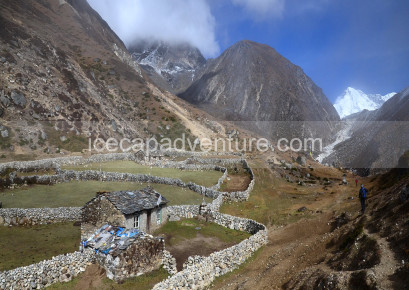.png)
.png)
.png)
.png)
.png)
.png)
.png)
.png)
Tamang Heritage Trekking Overview
Tamang Heritage Trekking is a cultural gem of Nepal, offering a rare chance to experience the warm hospitality and traditions of the Tamang people while exploring scenic Himalayan landscapes. Situated close to the Langtang region, this trek is an ideal journey for those who want to combine natural beauty with authentic cultural immersion. The trail passes through terraced fields, rhododendron forests, and quaint mountain villages, all framed by views of Langtang Lirung, Ganesh Himal, and Dorje Lakpa.
Nature and Wildlife
The trek unfolds through lush hillsides, pine forests, and rolling meadows, providing a soothing connection with nature. While the landscapes are dotted with rivers and waterfalls, trekkers may also encounter Himalayan birdlife and small wildlife. The backdrop of snow-covered peaks enhances the natural charm at every step.
Trekking Challenges & Rewards
This is considered a moderate trek, making it suitable for trekkers with average fitness levels. Trails include gentle climbs and descents, with rewarding cultural encounters and mountain views. Unlike more commercial trekking routes, the Tamang Heritage Trail offers peace, solitude, and authenticity.
Best Seasons to Visit
The best time to explore is during spring (March–May) and autumn (September–November). Spring colors the forests with blooming rhododendrons, while autumn provides clear skies and excellent mountain visibility.
Cultural Significance
The Tamang people, with their Tibetan-influenced roots, are known for their rich traditions, festivals, and hospitality. Trekkers can visit monasteries, observe local rituals, and experience homestays, making the cultural side of the journey as memorable as the natural beauty.
Highlights of the Trek
-
Immersive cultural experiences in authentic Tamang villages.
-
Stunning mountain views of Langtang Lirung, Ganesh Himal, and Dorje Lakpa.
-
Gentle trails suitable for moderate trekkers.
-
Traditional monasteries, chortens, and prayer flags along the way.
-
Scenic terraced fields, forests, and peaceful landscapes.
1
We will be waiting to welcome you at Tribhuvan International Airport, Kathmandu, where you will be greeted with a traditional Nepali flower garland to mark your arrival. After the warm welcome, we will drive you to your hotel, approximately 30 minutes during the day and 20 minutes at night.
Upon reaching the hotel, you will be offered welcome drinks and biscuits, followed by the settlement of your rooms. Once settled, please join us back in the lobby or meeting hall for a briefing about your trekking and tour program on Tamang Heritage Trekking, including an introduction to your trekking guide and other relevant details. After the briefing, you will have the opportunity to check your trekking equipment with your guide, and we will also explain the motor road to reach Machhakhola.
Note: If you arrive in Kathmandu at night, these activities will be scheduled for the following day after breakfast and meals.
.png)
.png)
.png)
.png)
2
After breakfast at the hotel, you will have time to explore Kathmandu’s cultural heritage sites, such as Kathmandu Durbar Square, Swayambhunath (Monkey Temple), or Boudhanath Stupa, and you will have the day to prepare for your trek.
Our team will assist you in checking your gear and ensuring you have all the necessary equipment for the journey ahead. If you need to buy or rent any trekking gear, we will guide you to the best shops in Thamel, where you can find quality items at reasonable prices.
In the evening, your trekking guide will conduct a final briefing about the trek, including route details, safety measures, and expected weather conditions. Overnight stay at a hotel in Kathmandu.
.png)
.png)
.png)
.png)
3
The journey begins with a 7–8 hour scenic drive from Kathmandu (1,350 m) to Syabru Besi (1,460 m), the starting point of the Langtang Valley Trek. Travelling by private jeep or local bus, the road winds through lush hills, terraced farmlands, and riverside gorges, offering glimpses of Ganesh Himal, Manaslu, and the Langtang mountain range on clear days. Along the way, you pass charming towns such as Trishuli Bazaar and Dhunche, experiencing rural landscapes and mountain villages. Upon arrival in Syabru Besi, you can rest in local lodges and prepare for the trek ahead.
Highlights of the Day:
-
Scenic 7–8 hour drive through hills, valleys, and terraced fields.
-
Stunning views of Ganesh Himal, Manaslu, and Langtang ranges on clear days.
-
Cultural encounters in small towns and villages along the way.
-
Arrival at Syabru Besi (1,460 m), the gateway to the Langtang region.
-
Comfortable evening in teahouses with local hospitality.
.png)
.png)
.png)
.png)
4
From Syabru Besi (1,460 m), the trek begins with a 5–6 hour uphill hike to Gatlang (2,238 m), a beautiful Tamang village rich in culture and tradition. The trail ascends gradually through forests, terraced fields, and hillside settlements, offering spectacular views of Ganesh Himal, Langtang Lirung, and Goljang Valley. After a few hours of climbing, trekkers reach Goljang village, a perfect rest stop with panoramic mountain vistas, before continuing to Gatlang. Known for its stone-built houses, terraced fields, and welcoming Tamang community, Gatlang offers a unique opportunity to experience authentic rural mountain life in Nepal.
Highlights of the Day:
-
Begin trekking from Syabru Besi (1,460 m) to Gatlang.
-
Trek through rhododendron and pine forests, terraced farmlands, and hillside villages.
-
Scenic views of Ganesh Himal, Langtang Lirung, and Goljang Valley.
-
Cultural encounters in Goljang and Gatlang villages, rich in Tamang heritage.
-
Overnight stay in Gatlang, famous for its traditional stone houses and warm hospitality
.png)
.png)
.png)
.png)
5
Leaving Gatlang (2,238 m), the trek continues with a 5–6 hour journey to Tatopani (2,607 m), a village famous for its natural hot springs. The trail descends first to the Chilime Hydro Project Dam, crossing a suspension bridge before beginning a steady uphill climb toward Tatopani. Along the way, trekkers pass through dense forests, terraced fields, and Tamang villages, enjoying breathtaking views of the Ganesh Himal and Langtang ranges. On arrival at Tatopani, meaning “hot water” in Nepali, trekkers can relax in the healing hot springs, a perfect way to rejuvenate after several days of trekking.
Highlights of the Day:
-
Trek from Gatlang (2,238 m) to Tatopani (2,607 m).
-
Scenic landscapes of forests, waterfalls, rivers, and terraced farmland.
-
Crossing the Chilime Dam and suspension bridge.
-
Stunning Himalayan views of Ganesh Himal and Langtang ranges.
-
Relaxation in the natural hot springs of Tatopani, believed to have therapeutic benefits.
-
Cultural immersion in traditional Tamang villages along the trail.
.png)
.png)
.png)
.png)
6
From Tatopani (2,607 m), the trek continues with a 4–5 hour journey to Thuman (2,338 m), a charming Tamang village renowned for its culture and traditions. The trail ascends gradually through alpine forests and terraced fields, leading to the scenic ridge of Nagthali (3,165 m), a popular viewpoint that offers sweeping panoramas of Langtang Lirung, Ganesh Himal, Shishapangma, and Tibetan peaks. After enjoying the breathtaking Himalayan views, the trail descends steadily toward Thuman, where trekkers are welcomed by the warm hospitality of the Tamang community. Thuman is well known for its Tibetan-influenced culture, monasteries, and traditional houses, making it an enriching cultural stop along the Tamang Heritage Trail.
Highlights of the Day:
-
Trek through forests, terraced farmland, and scenic ridges.
-
Visit Nagthali (3,165 m), a stunning Himalayan viewpoint.
-
Panoramic mountain views of Langtang, Ganesh Himal, and Tibetan peaks.
-
Experience authentic Tamang culture, monasteries, and traditional homes.
-
Arrival at Thuman (2,338 m), a culturally rich Tamang village.
.png)
.png)
.png)
.png)
7
From Thuman (2,338 m), the trek descends gradually on a 4–5 hour hike to Timure (1,762 m), following ancient trails once used as part of the Tibet–Nepal trade route. The path passes through forests, cultivated farmland, and small settlements, offering a mix of natural beauty and cultural heritage. On the way, trekkers experience the traditional lifestyle of the Tamang community, with opportunities to see stone houses, terraced fields, and prayer flags fluttering in the wind. Timure, a small but historically significant village, is located near the Rasuwagadhi border with Tibet, making it an ideal place to explore both culture and history.
Highlights of the Day:
-
Gradual descent through forests, farmland, and hillside settlements.
-
Cultural immersion in Tamang villages with Tibetan influences.
-
Learn about the ancient Tibet–Nepal trade route.
-
Scenic landscapes with views of valleys and surrounding hills.
-
Arrival at Timure (1,762 m), a culturally rich village close to the Tibetan border.
.png)
.png)
.png)
.png)
8
From Timure (1,762 m), the trail ascends gradually for 4–5 hours to reach Briddim (2,229 m), a traditional Tamang village that offers one of the most authentic cultural experiences on the Tamang Heritage Trail. The path winds through forests, terraced fields, and hillside ridges, with beautiful views of the surrounding valleys and distant peaks. On arrival, trekkers are welcomed into the homestay-based community of Briddim, where local families provide warm hospitality, traditional meals, and insights into Tamang customs. The village, with its stone houses, monasteries, and Tibetan-influenced culture, is a highlight of the trek, allowing visitors to immerse themselves in rural Himalayan life.
Highlights of the Day:
-
Trek from Timure (1,762 m) to Briddim (2,229 m).
-
Scenic landscapes of forests, farmlands, and ridges.
-
Stunning views of surrounding valleys and Himalayan foothills.
-
Experience genuine Tamang hospitality through homestay programs.
-
Cultural exploration of Buddhist monasteries and Tibetan-influenced traditions.
.png)
.png)
.png)
.png)
9
From Briddim (2,229 m), the trek descends steadily for 3–4 hours to Syabru Besi (1,503 m), completing the Tamang Heritage Trek circuit. The trail winds through forests, terraced fields, and small settlements, with scenic views of the Langtang Valley and surrounding hills. Along the way, trekkers pass through peaceful rural landscapes, where they can observe traditional farming practices and village life. Reaching Syabru Besi, the starting and ending point of the trek, offers a chance to relax in local teahouses, enjoy hearty meals, and reflect on the unique cultural and natural experiences of the journey.
Highlights of the Day:
-
Descent through forests, terraced farmland, and hillside villages.
-
Scenic views of the Langtang Valley and Himalayan foothills.
-
Opportunity to observe local village life and agriculture.
-
Arrival at Syabru Besi (1,503 m), completing the Tamang Heritage Trail loop.
-
Relax and celebrate the successful conclusion of your trek.
.png)
.png)
.png)
.png)
10
After breakfast in Syabru Besi (1,503 m), the journey continues with a 6–7 hour drive back to Kathmandu (1,350 m). The drive retraces the road through winding mountain highways, lush valleys, rivers, and terraced farmland, offering a final glimpse of rural Nepal. Passing through small towns and roadside villages, the ride provides time to relax and reflect on the cultural and natural wonders of the Tamang Heritage Trek and Langtang region. Upon reaching Kathmandu, you’ll be transferred to your hotel where you can enjoy a hot shower, rest, or explore the city in the evening.
Highlights of the Day:
-
Scenic drive through mountainous roads, river valleys, and terraced landscapes.
-
Beautiful views of villages, hills, and rural settlements along the way.
-
Return to the vibrant capital, Kathmandu (1,350 m).
-
Free time to relax or explore the city’s bustling markets and restaurants.
.png)
.png)
.png)
.png)
11
After days of trekking in the Himalayas, today is dedicated to rest, recovery, and leisure in Kathmandu. You can enjoy a slow morning with a relaxed breakfast before heading out to explore the city at your own pace. Popular options include shopping for souvenirs in Thamel, where you’ll find handicrafts, trekking gear, jewellery, and cultural artefacts. You may also visit Durbar Square, Swayambhunath (Monkey Temple), or Pashupatinath if you wish to explore more cultural sites. For those who prefer relaxation, you can indulge in a spa or Ayurvedic massage to soothe tired muscles. In the evening, enjoy a farewell Nepali dinner with cultural performances or sample international cuisine in Kathmandu’s vibrant restaurants.
Highlights of the Day:
-
Relaxation day after trekking, with no strenuous activities.
-
Shopping in Thamel and local bazaars for souvenirs, handicrafts, and trekking gear.
-
Optional cultural sightseeing in the UNESCO World Heritage Sites of Kathmandu Valley.
-
Opportunity for a spa treatment, yoga session, or massage for recovery.
-
Enjoy a farewell dinner in Kathmandu, celebrating the journey.
.png)
.png)
.png)
.png)
12
Your incredible Himalayan journey comes to an end today. After breakfast at your hotel, our team will assist with your transfer to Tribhuvan International Airport for your flight home or onward journey. Depending on your flight schedule, you may have time for some last-minute shopping in Thamel or a short stroll around the bustling streets of Kathmandu. As you bid farewell to Nepal, you carry with you the memories of breathtaking mountains, warm hospitality, and rich cultural encounters.
Highlights of the Day:
-
Hotel check-out and airport transfer.
-
Optional last-minute souvenir shopping or city walk.
-
Farewell to Nepal’s Himalayas, culture, and traditions.
-
Departure for your final destination with lifetime memories.
.png)
.png)

Didn’t find what you were looking for?
So why not plan your own trip. It takes only 2 minutes.- Airport Pick up and transfers to hotel.
- All accommodation in Kathmandu and Trekking.
- Full board meals during the trekking such as : Breakfast, Lunch and dinner.
- Properly 3 times tea and coffee whatever hot drink are available.
- Experience professional guide.
- Full support crew with 1 porter for every 2 trekkers.
- Full insurance for guide and porter.
- All transportation with AC deluxe from the starting to ending points of the trip.
- National park entry fee and TIMS card or trekking permit whatever needed.
- Down Sleeping bag (-20), must be returned after completing the trek.
- Trekking Maps and Notebooks.
- First Aid Kit for staff .
- Trekking achievement certificate after completed the Treks.
- All international flight tickets,Travel insurance and Nepal entry visa fees.
- Lunch and dinner in Kathmandu .
- All hard drinks such as : Mineral water, whisky, rum, cola, fanta, etc.
- Extra entrance fees such as : Museum, Monastry, Temple, Boating etc.
- Personal expenses like hot shower and battery charge / wifi.
- Extra night Hotel in Kathmandu if arriving early or late departure than scheduled Itinerary.
- Any emergency rescue evacuation and extra cost offering from unfavorable circumstance such as weather bad.
- Personal tips for trekking staff.

✅ Clothing
-
Base Layers (Thermal Tops & Bottoms)
-
Trekking Shirts (Long & Short Sleeves)
-
Fleece Jacket / Warm Mid-layer – For insulation.
-
Down Jacket – Essential for nights above 3,500m.
-
Waterproof & Windproof Jacket (with hood).
-
Trekking Pants (lightweight, quick-drying).
-
Warm Trekking Pants (for high altitude).
-
Waterproof Pants (for rain/snow).
-
Underwear – Comfortable, quick-dry.
-
Sports Bras (for women).
✅ Head & Hand Wear
-
Warm Hat / Beanie and Sun Hat / Cap.
-
Buff / Neck Gaiter / Scarf.
-
Sunglasses and Gloves 2 pairs
✅ Footwear
-
Trekking Boots – Sturdy, waterproof, broken-in.
-
Lightweight Shoes / Sandals – For camp/teahouse.
-
Warm Trekking Socks – At least 4–5 pairs.
✅ Sleeping & Bags
-
Sleeping Bag (Down -15°C) and Liner.
-
Duffel Bag (carried by porter).
-
Daypack (30–40L) – For personal items.
-
Rain Cover for Backpack.
✅ Trekking Gear
-
Trekking Poles & Gaiters – For snow or muddy conditions.
-
Headlamp (with extra batteries).
-
Water Bottles (2–3 litres) and Water Purification.
-
Personal First Aid Kit
-
Snacks / Energy Bars / Dry Fruits.
✅ Accessories & Personal Items
-
Sunscreen (SPF 30–50) and Lip Balm with SPF.
-
Toiletries and Hand Sanitiser.
-
Towel (quick-dry) and Toilet Paper
-
Camera / Power Bank / Solar Charger.
✅ Documents & Money
-
Valid Passport and Visa.
-
Travel Insurance (covers high-altitude & helicopter rescue).
-
Cash (Nepali Rupees) – For personal expenses.
Good to Know – Tamang Heritage Trekking
-
Best Seasons to Trek: Spring (March–May) and autumn (September–November) are the best seasons, offering clear skies, pleasant temperatures, and blooming rhododendrons. Winter trekking is possible but cold, while monsoon (June–August) brings rain and muddy trails.
-
Altitude Awareness: The trek usually reaches up to 3,000–3,200 meters, so the risk of altitude sickness is lower compared to higher Himalayan treks, but gradual ascent and hydration are still important.
-
Physical Fitness: This is a moderate trek suitable for trekkers with average fitness. Expect 5–6 hours of walking per day with some steep uphill and downhill sections. Basic training before the trek is beneficial.
-
Permits Required: Trekkers need the Langtang National Park Entry Permit and a TIMS card, both available in Kathmandu.
-
Accommodations and Meals: Tea houses in Tamang villages offer basic lodging and hearty meals, including dal bhat, noodles, soups, and traditional Tamang dishes.
-
Drinking Water: Bottled water is available but more expensive in remote areas. Carry a water purification system or tablets for safe refills.
-
Packing & Gear: Pack light but include essentials such as warm clothing, trekking boots, a waterproof jacket, a sleeping bag, walking poles, sunscreen, and a small first-aid kit.
-
Transportation: The trek begins with a drive from Kathmandu to Syabrubesi, the same gateway as Langtang Valley. Expect a bumpy but scenic journey.
-
Connectivity: Mobile network and internet are available in some villages, but higher and more remote sections may have limited or no coverage. Paid Wi-Fi may be offered at tea houses.
-
Travel Insurance: Comprehensive insurance covering trekking activities, medical emergencies, and evacuation is strongly recommended.

